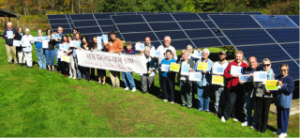Community solar: Great potential, but barriers remain
 Pointing to your solar panels and knowing that’s where your electricity comes from is a great feeling. Unfortunately, that’s a feeling a lot of folks can’t yet have. This is the case for a variety of reasons. Perhaps their roof faces the wrong direction, is too old, or covered by trees. Maybe they are renters.
Pointing to your solar panels and knowing that’s where your electricity comes from is a great feeling. Unfortunately, that’s a feeling a lot of folks can’t yet have. This is the case for a variety of reasons. Perhaps their roof faces the wrong direction, is too old, or covered by trees. Maybe they are renters.
Whatever the case, it is estimated that nationwide, about 50% of homes are not right for solar. This problem explains the growing popularity of community solar. A new report by the National Renewable Energy Laboratory (NREL) finds that community solar is poised to take off.
Community solar projects allow folks who can’t install solar on their own roof to buy into a project. They can then count a portion of the electricity the project generates against their own monthly utility bill, just as they would were the system on their own roof.
It’s easy to see why community solar is such an attractive proposition. NREL estimates community solar projects could add an additional 5 gigawatts to the annual distributed PV solar market in the next five years. This is enough energy to power more than 800,000 homes.
Barriers still remain. Only a minority of states have rules in place to allow for community solar. As with home rooftop solar, there is a fight over how much credit community solar participants receive on their bills.
Washington D.C. is perhaps the latest battleground for this fight. There, the Public Service Commission recently released rules that create two classes of solar citizens: homeowners with systems that receive credit at 13¢ per kWh and community solar participants that only receive 8¢ per kWh. Credit rates this low have essentially forestalled the development of community solar in the District.
This fight and those like it demonstrate the need to continue to educate policymakers and the public about the benefits of distributed renewable energy. Increasing their awareness will allow more folks to be able to point to where their energy comes from, even if its not on their own roof.
Check out our community solar information page to learn more.
